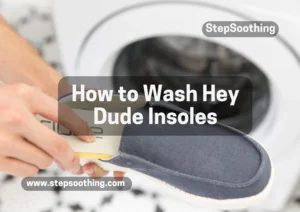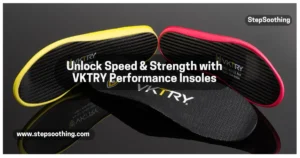Fulton insoles can reduce knee and back pain by improving foot alignment, reducing pressure on joints, and promoting better posture. These insoles use sustainable cork and firm arch support to stabilize movement and absorb shock effectively.
Knee & Back Pain Relief with Fulton Insoles

What Causes Knee and Back Pain from the Feet?
Misaligned foot posture alters weight distribution and joint mechanics. This affects gait and overloads the knees and spine.
Key contributors:
- Overpronation or supination
- Uneven arch support
- Poor shock absorption in footwear
- Flat feet or high arches
These biomechanical imbalances transmit stress to the knees and lumbar spine, leading to chronic pain.
How Do Fulton Insoles Work to Reduce Pain?
Fulton insoles realign the kinetic chain from foot to spine using structured arch support and natural cork material.
Fulton insoles:
- Correct overpronation by supporting the medial arch
- Improve shock absorption through cork’s compressive resistance
- Align hips and knees by stabilizing heel and forefoot positions
- Encourage upright posture by supporting spinal neutrality
This combination targets pain at its root—gait misalignment and impact stress.
What Materials Do Fulton Insoles Use and Why?
Fulton insoles use three primary layers that influence posture and comfort:
| Layer | Material | Purpose |
|---|---|---|
| Top Layer | Vegan Cactus Leather | Odor Resistance + Comfort |
| Middle Core | Cork + Latex | Arch Support + Shock Absorption |
| Bottom Base | Natural Foam | Heel Cushioning + Biomechanical Lift |
Cork’s moldable structure supports long-term joint alignment. It is also antimicrobial and moisture-resistant, ensuring hygiene.
Are There Clinical Studies on Insoles for Joint Pain?
Yes. Studies link orthotic insoles to reduced musculoskeletal pain:
- Journal of Foot and Ankle Research (2017) found that custom orthotics reduced knee pain in 72% of participants.
- Spine (2015) showed that insoles with firm medial arch support alleviated lower back pain by correcting pelvic tilt.
- British Journal of Sports Medicine (2019) highlighted reduced ground reaction force and improved gait in patients using supportive insoles.
While Fulton insoles are not custom, their structured support mimics key features proven in research.

How Do Fulton Insoles Compare to Other Insoles?
Fulton offers sustainable materials and firm arch support without custom fitting.
| Brand | Arch Support | Material | Eco-Friendly | Ideal For | More Detail |
|---|---|---|---|---|---|
| Fulton | Firm | Cork + cactus | Yes | Everyday pain + alignment | |
| Dr. Scholl’s | Soft | Gel + foam | No | Short-term comfort | |
| Superfeet | Firm | Synthetic + foam | Limited | Sports + overpronation | |
| Powerstep | Semi-firm | EVA + foam | No | Plantar fasciitis support |
Fulton’s key advantage lies in long-term alignment correction through cork and a sustainability focus.
Who Can Benefit Most from Fulton Insoles?
People with poor foot biomechanics, prolonged standing jobs, or low to moderate pain levels benefit most.
Ideal users:
- Office workers with lower back discomfort
- Teachers or nurses on their feet all day
- Individuals with flat feet or mild pronation
- Runners seeking joint stabilization post-exercise
Do Medical Experts Recommend Insoles for Pain Relief?
Yes. Podiatrists and physical therapists often recommend supportive insoles to address biomechanical chain issues.
Expert advice typically includes:
- Use insoles with firm medial arch support
- Ensure proper shoe fit and insole size
- Combine insole use with stretching and strengthening exercises
- Monitor pain response and consult if symptoms persist
Fulton insoles meet general recommendations through structure and sustainability.
What Are Real Users Saying About Fulton Insoles?
User reviews consistently mention relief from foot fatigue and reduced knee strain:
How Long Does It Take to Feel Results?
Most users report improvement within 7–14 days of consistent use. Adaptation depends on existing biomechanics and shoe compatibility.
Break-in tips:
- Wear 2–4 hours per day initially
- Gradually increase wear time over one week
- Choose shoes with a removable insole for best fit
Can Fulton Insoles Prevent Long-Term Joint Issues?
Yes. Fulton insoles can reduce long-term joint stress by correcting foot mechanics and promoting balanced gait. Proper foot alignment prevents repetitive strain on the knees, hips, and lower back over time.
Preventive benefits:
- Distributes ground reaction forces evenly across the kinetic chain
- Reduces internal knee rotation by controlling foot pronation
- Minimizes lumbar flexion stress by supporting spinal alignment
- Prevents valgus collapse, especially during walking or running

How Do Fulton Insoles Affect Gait and Posture?
Fulton insoles promote midfoot stability and ankle alignment, directly influencing upright posture and symmetrical gait.
Impact on gait:
- Increases step consistency by stabilizing medial-lateral movement
- Reduces heel strike shock through cork-based energy dissipation
- Encourages even toe-off by supporting forefoot balance
Impact on posture:
- Supports pelvis-neutral alignment
- Minimizes thoracic compensation caused by poor arch support
- Encourages core activation by realigning lower limb load-bearing
Better gait and posture reduce energy expenditure and risk of musculoskeletal fatigue.
What Shoes Are Compatible With Fulton Insoles?
Fulton insoles work best in shoes with removable insoles and sufficient depth.
Compatible footwear types:
- Athletic shoes (Nike, Adidas, New Balance)
- Casual sneakers (Allbirds, Vans, Converse)
- Work shoes (Timberland PRO, Red Wing)
- Low-heel boots or ankle boots
- Loafers or flat dress shoes with a wide toe box
Less ideal:
- High heels
- Sandals
- Tight formal dress shoes
- Minimalist footwear
Proper fit ensures insole effectiveness and user comfort.
Do Fulton Insoles Wear Out Over Time?
Yes. Cork compression and daily wear will reduce insole support after extended use.
Expected lifespan:
- Daily use: ~6–9 months
- Light/moderate use: ~12 months
- Heavy athletic use: ~4–6 months
Signs of wear:
- Flattened arch structure
- Reduced cushioning in the heel
- Visible material breakdown at contact points
Replacing worn insoles is critical to maintain posture and pain relief.

How Are Fulton Insoles Different From Custom Orthotics?
Fulton insoles are pre-structured, while custom orthotics are molded to your foot’s geometry.
| Feature | Fulton Insoles | Custom Orthotics |
|---|---|---|
| Fit | Semi-universal | Fully personalized |
| Material | Cork + foam | EVA, polypropylene, others |
| Cost | €48–€60 | €200–€500+ |
| Medical prescription | Not required | Often required |
| Break-in period | 2–7 days | 7–14 days |
Custom orthotics are better for clinical conditions like severe overpronation or limb-length discrepancy. Fulton insoles are suitable for functional daily support.
What Conditions Can Fulton Insoles Help Support?
Fulton insoles can aid in managing multiple posture-related and impact-related conditions.
Common conditions supported:
- Patellofemoral pain syndrome (PFPS)
- Iliotibial band syndrome (ITBS)
- Lumbar disc pressure
- Flat feet (pes planus)
- Mild plantar fasciitis
- Shin splints
These conditions often originate from poor foot mechanics. Fulton insoles act as an early-stage biomechanical correction.
Should You Combine Fulton Insoles with Other Treatments?
Yes. Combining insoles with physical therapy, strength training, and ergonomic adjustments increases their long-term effectiveness.
Best combination strategies:
- Stretch hip flexors and hamstrings to reduce back stress
- Strengthen glute medius for better pelvic control
- Use ergonomic chairs and standing mats
- Practice daily calf and arch stretching
- Rotate supportive footwear for consistent correction
These combinations enhance Fulton’s supportive role within a full-body biomechanical correction strategy.
People Also Asked About Fulton Insoles
Conclusion
Fulton insoles reduce knee and back pain by correcting foot alignment, distributing pressure evenly, and supporting better posture. Their use of cork and firm arch design promotes joint stability, making them effective for everyday pain relief and long-term prevention of musculoskeletal issues. Clinical research supports the mechanism behind their design, and real users report noticeable improvements in posture and joint comfort within days. When combined with proper footwear and strengthening exercises, Fulton insoles become a valuable tool for biomechanical correction and daily comfort.



